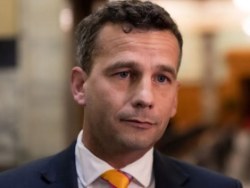Manukau Child Poverty Action Plan Released
Thursday 4th December
Manukau Child Poverty Action Plan Released
Te Ora o Manukau - Manukau the Healthy City has released the country's first action plan to address the issue of child poverty.
At a function held at Manukau City Council on 4 December, the plan was official launched and presented to the Manukau community. In attendance was Commissioner for Children Cindy Kiro and Mayor Sir Barry Curtis.
Bob Newman, Co-Chairperson of Te Ora o Manukau – Manukau the Healthy City says "The objective of this plan is to strive to eliminate the 'pockets of poverty' that exist in the City, working towards healthy and well-housed people who are economically secure, active and involved in their community."
The Collaborative Action Plan on Child Poverty in Manukau provides a tool for businesses, community organisations and local and central government agencies, to inform and shape their policies and services for Manukau children. It outlines objectives, strategies and activities for addressing child poverty with the emphasis on collaborative community action.
The recently released United Nations Report 2003 highlights concerns for New Zealand children with reference to persistence of poverty. The report recommends that the government makes it a priority to tackle child poverty.
Children make up a high
and growing proportion of Manukau's population, with 27
percent being under the age of 15 years. The report finds
that Manukau children have been disproportionately affected
by poverty. Through analysis using NZDep96, a tool for
relative ranking of areas in the country from least to most
deprived, and identifying the socio-economic deprivation of
an area, it is found that 45 percent of Manukau children
live in areas of highest
deprivation.
continued….
-2-
Poverty-related problems include inadequate housing with associated overcrowding, under-employment, hidden hunger and lower educational achievement.
The impact of poverty on Maori, Pacific peoples and new settlers is highlighted in the report.
Twenty three percent of Manukau’s children under 15 years are Maori. These children are at risk of living in families experiencing poverty. Of all Maori living in Counties Manukau, 72 percent live in the highest deprivation areas.
The report states that Maori children are more likely to experience poor health, have higher rates of youth unemployment and fewer educational qualifications.
The report states that Pacific people in Manukau are predominantly poor and working class with a median income of $14,800 compared to other groups' median income of approximately $19,000 per annum. Many Pacific people are unemployed or are employed in low skilled areas. Pacific people have lower educational achievement than other ethnic groups and are less likely to own a business or be in highly paid employment.
Seventy percent of Pacific children live in the most deprived areas in New Zealand. Of all the Pacific peoples living in Counties Manukau, 90 percent live in the highest deprivation areas.
Refugee children and their families in particular, suffer the impact of poverty, poor physical and mental health and low educational achievement due to their often traumatic backgrounds.
Mayor, and patron of Te Ora o Manukau - Manukau the Healthy City, Sir Barry Curtis, says, "It is true that many poor families make sacrifices to give their children the best possible start in life. But the broader picture shows that those who grow up in poverty are more likely to have learning difficulties, drop out of school, resort to drugs, commit crimes, be out of work, become pregnant at too early an age, and live lives that perpetuate poverty and other disadvantages into succeeding generations. Poverty also impacts on the national economy and national well-being. It may present a major, though largely hidden cost to society – the cost of talent lost.
"The Action Plan will require commitment from the community, our council, and from central government to implement the actions within it."
continued…..
-3-
Copies of the plan are available from the website www.manukau.govt.nz/healthycity.htm or by phoning Roni Taylor on 09-2628900, ext 8470.
ENDS
Agencies and
organisations who contributed to the plan include:
AIMHI
Community School Projects Auckland Regional Public Health
Service
Child Youth & Family Counties Manukau District
Health Board
Counties Manukau Food Banks
Association Counties Manukau Health Promoting
Schools
Food in Schools Programme (Resources to Schools
Charitable Trust)
Housing New Zealand Corporation Inland
Revenue Department
Injury Free Counties Manukau Kidz
First Public Health Nursing
Manukau City Council
Middlemore Primary Health Organisation
Ministry of
Education Ministry of Health
Ministry of Pacific
Island Affairs Ministry of Social Development
Mokopuna
Ora Plunket, Kaiawhina and Karitane
Sisters of
Mercy South Auckland Family Violence Prevention Network
South Seas Kids Taikura Trust
Tamaki ki Raro
Trust Tamariki Ora
TaPasefika Health Trust Te
Kupenga o Hoturoa
Te Puni Kokiri The Primary Health
Network for Manukau
The Salvation Army Total
Healthcare Otara
Work and Income
Background to Te Ora o
Manukau – Manukau the Healthy City
Te Ora o Manukau -
Manukau the Healthy City Charter has 49 signatories to its
charter representing central and local government agencies,
community organisations and local businesses each committing
to work together for the health and wellbeing of Manukau’s
residents. Manukau City Council is a key partner in this
initiative.
Manukau is one of over 1800 cities or
communities worldwide involved in 'Healthy Cities' - a
project of the World Health Organisation. In Manukau the
immediate means of achieving the goals are:
¨ Promoting a
team approach to resolving community concerns
¨
Inter-agency co-ordination and resource sharing
¨
Ensuring that relevant data is available and shared
¨
Setting in place opportunities for community expression of
interest and need
¨ Organising joint agency/projects to
resolve key issues.
The objective is to set in place strategies and processes which focus on the two main elements of action - the development of healthy public policy, and the development of greater community participation in decision making.


 Gordon Campbell: On Iran Killing Its Rappers, And Searching For The Invisible Dr. Reti
Gordon Campbell: On Iran Killing Its Rappers, And Searching For The Invisible Dr. Reti Labour Party: National Should Heed Tribunal Warning And Scrap Coalition Commitment With ACT
Labour Party: National Should Heed Tribunal Warning And Scrap Coalition Commitment With ACT Government: Saves Access To Medicines
Government: Saves Access To Medicines Office of the Speaker: Law And Order, Finance, And Defence A Focus For Ukrainian Parliamentary Delegation To NZ
Office of the Speaker: Law And Order, Finance, And Defence A Focus For Ukrainian Parliamentary Delegation To NZ Environmental Defence Society: Fast-track Approvals Bill Presents A Serious Risk To New Zealand Exporters
Environmental Defence Society: Fast-track Approvals Bill Presents A Serious Risk To New Zealand Exporters NZ Government: New Lab To Help Protect Key Pacific Tuna Fisheries
NZ Government: New Lab To Help Protect Key Pacific Tuna Fisheries Susan Botting - Local Democracy Reporter: Ruawai Leader Slams Kaipara Council In Battle Over $400k Property
Susan Botting - Local Democracy Reporter: Ruawai Leader Slams Kaipara Council In Battle Over $400k Property


